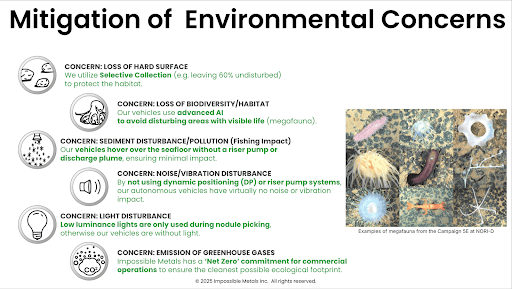Impossible Metals was explicitly founded to address the environmental concerns surrounding deep sea mining of polymetallic nodules, so here’s how we address each of the five concerns listed in the previous answer:
- Loss of Biodiversity: By avoiding picking up visible life (megafauna) and leaving behind a percentage of nodules, our system minimizes the potential for destruction of animals for their own sake, for the ecosystem, and for any potential human uses.
- Sediment Disturbance & Pollution: Our underwater robots—formally known as Autonomous Underwater Vehicles (AUVs)—have a variety of features that minimize sediment disturbance:
- Our AUVs hover over the seafloor so they do not disturb sediment from landing or driving over the seafloor.
- The buoyancy engine makes the robot positively buoyant while it hovers over the seafloor, meaning thrusters push upward, not downward into the sediment.
- Robotic arms/claws pick up nodules individually, minimizing sediment pickup.
- The AUVs move up and down the water column, avoiding the need for a riser pump system and its discharge plume.
- Noise & Vibration Disturbance: Our sound emissions are relatively low. Most sound subsea will come from the acoustic communication system, subsea thrusters, and buoyancy pumps. The surface sound will be from the ship and the launch and recovery operations of the underwater robot. As part of our equipment’s environmental design basis, we have aimed to generate minimal sound. In particular, we have aimed for minimal sound compared to dredge-based equipment. Substantial sound comes from DP {Dynamic Positioning) ships and the riser system. We do not require DP or risers. Our sound profile is small compared to other technologies.
- Light Disturbance: Today, we use visible white light. We are working with marine scientists to determine the best wavelength (color) to have the least impact. In production, we may reduce the light power by using more sensitive sensors in our cameras. We will work with scientists to measure the effect on the marine ecosystem.
- Loss of Hard Surface: Selective harvesting allows us to leave behind a percentage and/or pattern of nodules that maintain the ecosystem’s hard surface and avoid nodules with attached visible life (megafauna). Our current economic models assume we will leave 20% of nodules behind, but this estimate will be refined through study and discussion with scientists.
- Emission of greenhouse gasses: Our plan for producing responsible metals includes a commitment to carbon neutrality. This means we will minimize emissions as much as possible and use carbon offsets for any remaining impacts. We report annually on our environmental impact. Our selective harvesting system design minimizes emissions in the following ways:
- AUVs are electric, and we are investigating renewable energy sources for battery charging
- No riser pump, ship-to-ship transfer, or onboard separation of nodules from sediment and water
- We are working on a launch and recovery system that does not require our ships to have dynamic positioning.
